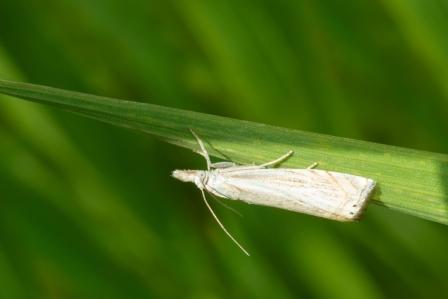Sod Webworms
Sod webworms (family Pyralidae) are a group of insects including over 20 species that infest turfgrasses in the United States. Among the more important species that can damage turfgrass are those in the genus Crambus. Adult sod webworms, sometimes called lawn moths, are tan-colored, 1/2 to 3/4 inches long. At rest, they fold their wings around their body, for a cylindrical-shaped appearance. Sod webworm larvae (caterpillars) are gray to tan with small dark spots on the body. When fully grown, they reach 3/4 to 1 inch in length.

Sod webworms overwinter as larvae in the thatch and soil. In most years, larval activity in cool-season areas resumes in April or early May. Webworms complete development, pupate and emerge as adult moths from May into June. Adult moths tend to be in the turf and on nearby shrubs during the day. They randomly scatter their eggs into the grass in the late afternoon and early evening. Eggs hatch in about one week. First-generation larvae feed until mid-summer. A second and third generation usually occur during the remainder of the season. Often, generations overlap with all stages present by late summer.
Sod webworm moths (adults) do not damage turf. Larvae do the damage, feeding at night on grass leaves and stems near the soil surface. They feed on most turfgrasses including bluegrass, tall and fine-leafed fescues, zoysiagrass, bentgrass, and buffalograss. In warmer climates, they also feed on St. Augustine grass and many other warm-season grasses. Under heavy sod webworm pressure, large areas of turf can be defoliated and even killed during periods of summer heat and drought. While sod webworm larvae are active from early spring through fall, the most serious turfgrass injury usually occurs in mid to late summer when turf is already stressed. Sound cultural practices, especially proper irrigation, will often allow turf to outgrow moderate webworm injury.
If insecticides are used, it is best to mow the turf and remove the clippings before treatment. This will enhance insecticide movement into the turf canopy. A thorough irrigation (1/2 to 3/4 inch) prior to application will also move webworms closer to the surface. For best results, apply insecticides in the late afternoon or early evening when larvae are active. Following application, the treated area should be lightly irrigated (1/8 inch). Delay heavy watering for 24 to 48 hours unless irrigation is indicated on the insecticide label. Granule applications in particular should be lightly irrigated immediately after application to wash granules off grass blades and activate the insecticide.
LebanonTurf offers several products that are labeled to control sod webworm populations:
- Bifenthrin – with fertilizer or on inert granules
- Allectus – with fertilizer
- Acelepryn – with fertilizer
- Sevin (carbaryl) – on inert granules
Consider these products for the control of Sod Webworms:
ProScape 15-0-5 40% MESA .067 Acelepryn
Lebanon Pro 17-0-3 40% SCU 3% Fe .225 Allectus
Lebanon Bifenthrin .1G HDG Insecticide
Other products for controlling Sod Webworms can be found here
All products are applied with a dry granule spreader. General application timing is May through September – which is when the moths are visible. Follow all specific label directions when using these products.